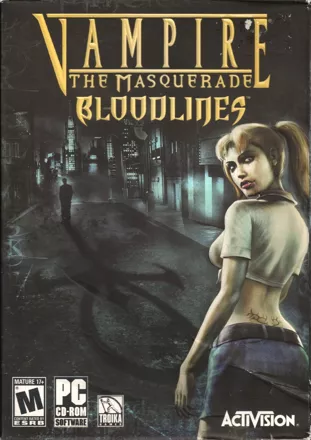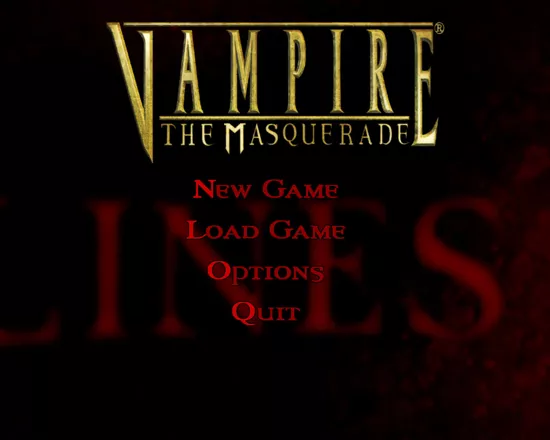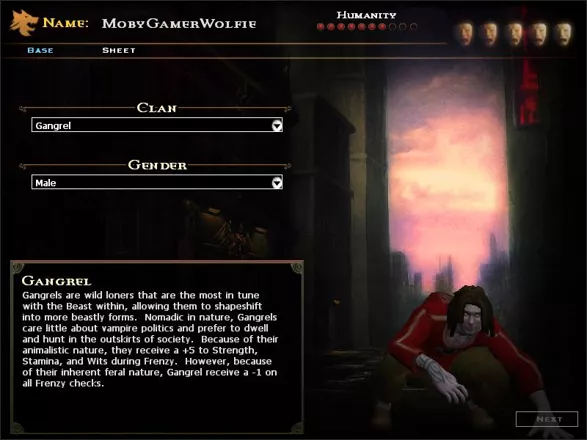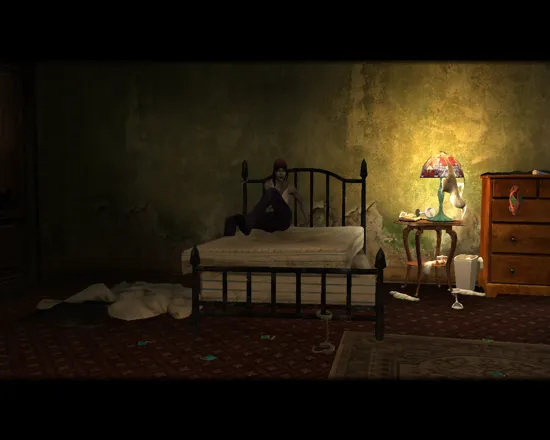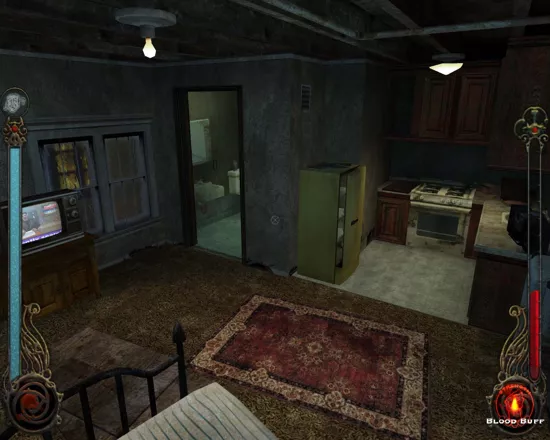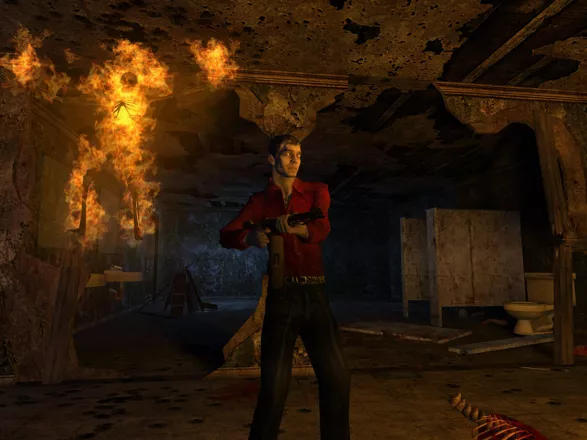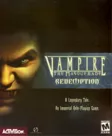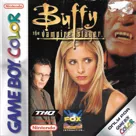Vampire: The Masquerade - Bloodlines
Description official descriptions
One morning, a seemingly ordinary inhabitant of modern-day Los Angeles wakes up and discovers that he (or she) is dead. Well, not exactly dead, but turned into a vampire - "sired", as the vampires themselves call it. Before the protagonist is able to reflect upon this new and unexpected form of existence, he is taken to a courtroom, where he gets acquainted with the Camarilla - an organization that preserves order among vampires. Apparently, the protagonist's sire turned him into a vampire without permission, so Prince LaCroix, the head of the Los Angeles Camarilla branch, decides to execute both. The hero's short vampire life would have come to an abrupt end if a mysterious person hadn't stepped in and convinced the Prince to spare it. The Prince takes responsibility for the protagonist from now on and decides to test his abilities, sending him to Santa Monica. Before long the new vampire becomes involved in a net of intrigues between powerful organizations and vampire clans and must choose his own place in this terrifying new world.
Vampire: The Masquerade - Bloodlines is based on the pen-and-paper RPG Vampire: The Masquerade. In the beginning, the player creates the protagonist, choosing between vampire clans, each with its own unique abilities and disciplines: Brujah vampires are suitable for melee fighting, Tremeres can cast spells, etc. In some cases the choice of a clan greatly changes subsequent gameplay: for example, Malkavians are insane and will therefore have completely different surreal dialogue choices; Nosferatu are so ugly that they can't pass for humans and will have to travel through underground paths throughout the game, etc.
The main character gains experience points only for completing quests, not for killing enemies. Many side quests are available during the course of the game. Experience points can be manually allocated to raise the protagonist's attributes, as well as improve various vampire feats. The player can make the main character stronger in combat, proficient in computer hacking or stealth, more powerful in vampire disciplines, more attractive, more intimidating, and so on.
Combat in the game is action-based. The protagonist can fight unarmed, use melee weapons and firearms, or employ special vampire abilities. Melee combat is viewed from the third-person perspective, but the view switches to first-person if the main character is using a gun. Blood is used to activate the vampire disciplines, working similarly to magic points in other games. It can be replenished by feeding on certain types of enemies.
The protagonist can also feed on innocent humans, though there are repercussions for that. The rules of the Masquerade forbid vampires to reveal their true nature to humans. Openly feeding on humans violates the Masquerade; five Masquerade violations lead to an instant Game Over. Feeding on humans with no witnesses present does not violate the Masquerade; however, killing an innocent human in the process alerts the authorities and causes the player character to lose some of his or her humanity. Losing too much humanity results in the protagonist becoming more and more susceptible to frenzy, eventually turning into an uncontrolled beast.
Many quests can be completed in different ways - brute force, stealth, diplomacy, intimidation, etc., depending on the preferred style of play and the main character's attributes. The player will also have to decide which faction the protagonist should side with throughout the game. Eventually, the player's choices will branch the storyline, leading it to one of the five possible endings.
Spellings
- 吸血鬼:避世之血族 - Chinese spelling (simplified)
Groups +
- 3D Engine: Source
- Gameplay feature: Character development - Skill distribution
- Gameplay feature: House ownership
- Gameplay feature: Multiple endings
- Green Pepper releases
- Middleware: Bink Video
- Physics Engine: Havok
- Protagonist: Female (option)
- Protagonist: Vampire
- Setting: City - Los Angeles
- Setting: Hotel
- Software Pyramide releases
- Sound engine: AIL/Miles Sound System
- Theme: Haunted house
- Theme: Vampires
- Vampire: The Masquerade licensees
- World of Darkness
Screenshots
Promos
Videos
Add Trailer or Gameplay Video +1 point
See any errors or missing info for this game?
You can submit a correction, contribute trivia, add to a game group, add a related site or alternate title.
Credits (Windows version)
316 People (275 developers, 41 thanks) · View all
| Creative Director | |
| Project Lead | |
| Lead Programmer | |
| Programmers | |
| Additional Programming | |
| Lead Scripter | |
| Scripters | |
| Additional Scripting | |
| Lead Animator | |
| Lead Character Modeler | |
| Animators | |
| [ full credits ] | |
Reviews
Critics
Average score: 81% (based on 48 ratings)
Players
Average score: 4.2 out of 5 (based on 162 ratings with 14 reviews)
Enjoy This Game, No Matter How Hard it Tries to Stop You
The Good
Vampire Bloodlines is, without a doubt, a huge improvement over its predecessor. Vampire: The Masquerade: Redemption was perhaps more polished to some degree, but it had its share of awful bugs and game design decisions, and a less satisfying story. Vampire Bloodlines turns the game into an FPS RPG, and for the most part, this is a good move. It retains the dark and gritty feel of the first game, and puts it to good use, creating a garish, sin-filled version of Los Angeles.
I am normally amused and disappointed by games that are formulaically “mature.” The use of the word mature often means three things: cursing, lots of violence, and overt sexuality. Bloodlines has these in spades, buts it’s a testament to the game’s good writing and plot that these elements were only a minor deterrent. Most characters have interesting stories and dialogue to impart, and the Source engine brings their faces to life, as does some surprisingly good voice acting. Just brace yourself for some very vulgar and sexually explicit dialogue. This is supposed to be an L.A. filled with vice-ridden, hedonistic, super-violent immortals, after all.
In the world of Bloodlines, there are 7 clans of vampires. You can play any of them, and all have their own strengths and weaknesses. Some, like the Nosferatu are hideously deformed near-animals. They may be powerful, quiet and deadly stalkers, but they can’t blend in with humans. The Toreador, on the other hand, are powerful, suave aristocrats. They can’t feed on “impure” (re: rats, poor humans, “low blood”) victims, but they have political clout and old-money class.
Regardless of what class you pick, you’ll be able to level up your combat, magic (various “blood” spells) and more intellectual skills. These affect the gameworld noticeably. Try picking a lock, sneaking past a guard, or firing a shotgun at first level, and then do it again when you’ve spent 3 or 4 points on the skill. You will notice a huge difference. Bloodlines is an RPG to its core. Don’t make the mistake of letting its FPS perspective fool you. This is the natural evolution of its third-person predecessor, stat points, imaginary dice-rolls and all.
Bloodlines offers some surprisingly scary and well-designed levels. When you aren’t wandering around Hollywood or Santa Monica, looking for quests and blood, you’ll be sent on individual missions, which take place in separate levels. Some levels, like the abandoned (and possibly haunted?) hotel, the insane asylum, and a graveyard practically drip with fear and tension. One quest that has you investigating a series of increasingly sadistic snuff films is one of the scariest encounters I’ve ever had in a video game.
The combat is fun, if a bit awkward, and all of your abilities are useful, in one way or another. The persuasion and intimidation options are fun, but the best conversation technique of all is saved for one particular clan of vampires. The Malkavians are all half insane, and thus your responses to conversations are all in bizarre Cheshire cat speech. Even better, you can use some blood to make other people just a little crazy, winning them over to your point of view.
The game allows you to really customize your world, with different apartments to move into, different clothes and armor, and different ways of completing almost every mission. You’ll realize that you can complete each mission a number of different ways: sneaking, fighting, magic, charming, intimidating, and ultimately a combination of several of these. This free-form gameplay reminded me a lot of Deus Ex, but in a much more interesting world, to be honest. That is actually on of the highest complements I can give this game, actually. It is the spiritual successor (in gameplay if not in style or construction) of one of my favorite FPS RPGs of all time.
The Bad
Sadly, Bloodlines is absolutely chock-full of mistakes. The animations are for the most part awkward and badly implemented. Likewise, the interface for combat is clunky and hard to use. The Source game engine, used so masterfully by Valve, looks close to ugly here. While the graphics may muster up some truly frightening set pieces, they can also break you out of the game entirely, textures popping in and out and people sticking their arms through walls.
There is evidence of missing or cut quests all over the place: pointless items, broken dialogue, etc. It’s obvious that Troika had some grand plans for this game, and couldn’t or didn’t have the time to implement them. Some of the weapons are overpowered, and some of the classes aren’t balanced properly. The game takes forever to load in many cases, despite being run on a computer that easily destroys its recommended requirements. Finally, the game is incredibly unstable, glitching and crashing frequently.
The Bottom Line
Despite that seemingly insurmountable list of problems, I would still recommend this game to fans of RPGs, FPS RPGs, and White Wolf’s Masquerade universe. This game is one of the deepest and most interesting RPGs I have ever played. It actually puts its gritty urban setting to use (unlike so many games), crafting a bizarre nightmare version of our own dangerous cities. It provides a truly interesting story, great character development, and a terrifically tense and atmospheric experience. However, the number of bugs, glitches and imbalances in the game threaten to ruin it.
The only way to get this great game to be even barely playable is to download the latest fan-made patch, unfortunately. The community patch provides all of the fixes that Troika should have put into the game before it went gold. Modern resolutions are added to the game’s options (this makes a huge difference), broken quests are fixed, missing quests are added, powers and weapons that got cut are added in, character creation is fleshed out, and most importantly, the game is stabilized.
So, if you want a deep, scary and engrossing RPG, get Vampire Bloodlines. You’ll have to a masochist or an extremely odd brand of gamer to appreciate it though, even with the patches.
Windows · by Tom Cross (28) · 2008
A fitting epitaph for a passionate, yet flawed, development house.
The Good
Troika proved with its first game that it really knew how to create depth in a game world when handling role playing. This game proves to continue that tradition, as role-playing really shines in this game.
You start by selecting a vampire type, each with its own strengths, weaknesses and a special power only allowed to the particular vampire family. And each character type is an experience in itself: The ugly Nosferatu who must hides its visage from humans or risk revealing the masquerade; the beautiful Toreador who easily moves through humanity, seducing their victims; the Brujah who viciously use their muscle to get what they want; the insane malkovians who can’t seem to communicate to others without creating and uncomfortable situation, yet have better insight for it. As you see, there are many paths to follow allowing some replayability as you try various vampires.
From this you will go into the dark under belly of LA, feeling your way through intrigues, lies, and plots. In the process you will get various quests you can solve to ingratiate yourself with the denizens of the everlasting night. On resolving each quest, you gain experience and levels, which allow you to pour points into various skills and abilities. You may do so as you wish, though your choice of vampire type will make some skills more expensive than others. This allows even more customizability by choosing individualized skills for your vampire.
When you do go into the world, you will need to work within the rule of the Masquerade. You must avoid human understanding of what you are, or you could be punished. This is a great gameplay obstacle, and can be used to change how you are looked at. On top of this is the bloodlust you must satisfy. All major skills use blood and damage taken can only be healed by blood. So, you will need to find ways to sate the lust or risk permanent death. These limits of the game world do add to the gameplay and keep it fresh and risky.
As you move through the various areas of LA, such as Hollywood, Santa Barbara, and China town, you will meet quite a few great and personable NPCs. Each has memorable dialogue and are generally well voiced. Main NPCS are well rendered as well, making them feel more real. I always enjoyed interacting with them, as the menu driven conversations have many paths and allow many reactions. Even your powers will add more reactions, depending on ability. The best are the Malkovian responses, creating quite humorous reactions.
Various quests these NPCs will give you will keep you interested and are rarely repetitive. You will get to try your hand at fighting monsters, sneaking into various companies, hacking computers and many other actions. You will even get to try various skills in missions to accomplish your tasks, such as either talking or fighting your way in the Chinese theater. But this is not always the case as I mention in the bad.
Various locations are generally well done, and a few are pretty darned exceptional. The hotel is one of the best scary places I’ve seen in gaming in a long time. It oozes a kind of fun house atmosphere that is really enjoyable. I also found the psychiatrist’s mansion a weird but interesting area, reminiscent of Thief’s Balfor mansion.
This leads to the area of graphics. My first error was to play this alongside Half Life 2, which truly is an unfair comparison. Though there are bugs (mentioned below) many of the scenes are well detailed and nicely designed. Some are better than others, such as Chinatown and the Nosferatu town. For an RPG, the look of the graphics are well done. But there are some issues with performance, and some areas leave much to be desired.
Finally the story is very good. It is rather linear, but has its own twists and turns, mostly depending on you. Much of the best story is in the sidequests where you learn more about the politics of being a vampire. And you do get to determine the ending, and I suggest you try them all for they do have some surprises and nice cinematics. I felt the ending was well done, though there are some other opinions. And though you never really get to know your character, you do get a taste of White Wolf’s vampiric world.
The Bad
When it comes to role playing and characterization, Vampire gets a gold star. But battling enemies is another story. Despite multiple skills, battles devolve mostly in to clicking on the enemy to defeat them. Magic allows for some strategy, but the speed of battles can undermine thoughts of strategizing. And some of the tougher battles will use up your blood skills quickly before you can finish off the enemy. Enemies have a tendency to run up and attack without much thought to their actions. Many times you will use your powerful skills to kill enemies quickly without much more action.
For all the intricate character customizability, some of this gets lost in many actual quests one can undertake. Many of the actions emphasize only one or two skills, such as the zombie hunt requiring good gunplay. This would not be so bad if it were only the sidequests, but many of the main quests demand use of few skills, such as the need to sneak through the museum to get some of the best experience. If you leveled in the personality orders, you’ll find they get lost through many of the missions. There are some spells that will allow you to buff up your weaker skills, but it would still be nice to play through each as you have developed your character, not force your character into unnatural actions.
The final levels are the worst. Be prepared to use the last of your experience to beef up fighting skills and battle magic. You will be doing a lot of fighting and will have a hell of a time if you only poured your skills in other areas. This undermines the role playing strength of the game.
Another issue is the bugs. Many of the worst were fixed in the patch, but there are plenty of others. The graphics are choppy on the best of machines (I figure my ATI Radieon on 2.5 GHz machine is no slouch) and moving areas such as elevators skip around. I don’t blame Troika as much on this because Valve made a patch for the same issues in Half Life 2, but did not distribute it to Troika, leaving many problems in.
Load areas feel much like another bug, but they are a weakness a graphics heavy engine. Going in and out of buildings lead to all sorts of load times, and it can be frustrating to move around. On top of this, the places you go are both limited to a few areas and the areas feel artificially closed. There are many times I was confronted with strange barriers that shout “You are in an artificial room created by game developers!” Plus, it appears more areas were promised than delivered. Take a look at the box, I never saw that cowgirl anywhere.
Along with this are the graphical issues that can undermine believability. There are a lot of twins in the game at various places. Many of the body models can be so simple compared the the NPCs that it feels shoddy. And some areas are rather bland and repetitive (welcome to the sewers). Of course, much of this comes from the Half Life 2 comparison, and for an RPG, its not too bad.
The Bottom Line
Troika’s third and final game takes them to unfamiliar territory in creating Deus Ex style shooter. What they add is a deeper role playing system and in-depth character interactions. But, there are problems standard to Troika’s fare: bugs, a less then satisfying breadth of area, a linear finale with minor, though intriguing, choices in the end. They overreach at expansive gameplay and world but come up somewhat short, concentrating their efforts in a few areas leaving the game unbalanced, as if there could be so much more.
Despite the flaws, Troika does excel at what they concentrate on. This leads to a game that is well worth playing for to see how well they can do some things and leaves one wondering how well they could have made games had they found balance. So, if you want a fine example of idealistic zeal for creating great role-playing, characterization, and story, you can’t go wrong with this gem.
Windows · by Dwango (298) · 2005
Once again, pure RPG bliss courtesy of Troika
The Good
As every fan of role-playing games should know, the guys from Troika Games played a major role (no pun intended) in the creation of the landmark title Fallout. As they established themselves as an independent game-developing company, they delivered Arcanum, one of the most interesting and flexible RPGs known to mankind. Bloodlines is their most original work; based on a pen-and-paper rule set used, to my knowledge, only once before in a video game, it is gorgeous, deeply satisfying, and impossible to put down for all the reasons you love RPGs for.
Bloodlines draws inspiration not only from classic "pure": RPGs, but also from hybrid games, most notably Deus Ex. A more traditional RPG than that seminal game at heart, it nevertheless has elements of a third-person action game and first-person shooter. Its action is clever, it depends on the way you have customized your character, and most problems can be solved in two or more different ways. In fact, Bloodlines belongs to en exceedingly rare breed of role-playing games that retain much of their genre's depth but are no strangers to inspiration coming from other styles.
Already the character creation gives you an idea about what a wonderful role-playing experience you are treated to. Different vampire clans are defined in a uniquely appealing way: instead of the usual fighters and clerics you'll have a choice between beast-like Gangrels who can summon ferocious animals; insane Malkavians who have unique dialogue lines seemingly taken from a surrealist book; ugly Nosferatu who must hide from humans during the entire game, and so on. The differences in the playing styles of all those creatures are sometimes so big that the game begins to shift genres depending on your choices: it can become a hack-and-slash melee game, a shooter, a stealth game, and more.
Unlike most other RPGs, you don't gain experience points from battles in this game, but only from completing quests. This encourages speech-related approaches and also makes it possible to run away from some difficult battles without fear of losing valuable experience. When you gain experience points, you distribute them to raise various attributes of your character. The role-playing system of Bloodlines is varied and flexible. Besides just making your character stronger and tougher, you can upgrade such skills as lockpicking and stealth, as well as feats such as persuasion or seduction. In a true role-playing fashion, the game allows you to do whatever you like. Feel like hacking computer terminals, picking locks and silently creeping past unsuspecting guards? You can do that. More inclined towards diplomacy? Raise your charisma and persuasion, and you'll be able to complete many quests which can't be solved with stealth or brutal force. And maybe you'll spare yourself a fight or two. Or just make yourself sexy and seduce people in bars and discos. You can do all that. Welcome to real role-playing.
There is also plenty of vampire-exclusive stuff in this game. After all, you are playing an immortal creature, you can't be killed in conventional ways, and you can drink blood, right? Of course! All those vampire aspects are beautifully integrated into the gameplay. First of all, there is the Masquerade. It means that you are not allowed to reveal to humans your true nature. So, if you are playing as a Nosferatu (who don't look human), you can't even allow yourself to be seen. If you violate the Masquerade, be it through reckless mentioning of vampires in conversation, public blood-drinking, or usage of your special disciplines in front of human witnesses, you get a warning. Five such warnings, and the game is over. You should also pay attention to your Humanity: you are constantly reminded that even as a vampire, you needn't be evil. Yes, you are a dark creature, a predator, a blood-sucker, but that doesn't mean that you should go on a rampage killing innocent people. If you do anything of the kind, you'll lose Humanity. The less Humanity you have, the more you will be inclined to uncontrolled frenzy.
The "meat" of this game are the quests. Of course, theoretically you can just follow the main story quests and be done with the game, but first, you'll really need the experience, and second, those quests are for the most part quite exciting and original, sometimes even more so than the main storyline. You'll get various simple bad guy-killing or item-retrieving assignments, but also such interesting material as preventing a book from being published, criticizing food in a restaurant, or convincing a girl her boyfriend is really not interested in her. Many quests can be completed in various ways - persuasion skill plays a particularly important role. Will you kill a person, lockpick his office, or convince him to do what you want? The choice is yours.
When you fight, you do it either by punching your enemies, using melee weapons, or shooting. To use your vampire disciplines (some of which are unique to certain clans, so you'll never see all of them unless you play the game several times), you need blood. Blood points is another excellent vampire-related twist to the traditional usage of MP. Each discipline requires a certain amount of blood. Those disciplines range from increasing your attack power to driving your opponent insane. Blood points can be replenished by drinking blood packs, but of course a much cooler way is to feed on your enemies, if they are human. High unarmed combat rating increases your chances of successfully feeding on an armed enemy. This way you can replenish your blood points and health as well. The fights are exciting, there are different melee weapons and guns to try out, and overall combat is nearly as satisfying as are the quests.
Bloodlines is set in one of the most unforgettable worlds ever seen in a video game. The atmosphere in this game is, quite simply, amazing. The visual design is absolutely fabulous. Never mind the technical quality of the graphics - it's their artistic touch that makes them shine; the incredibly stylish set-up, with all kinds of weird and grotesque ideas, full of imagination - gothic horror, immense sensuality, and decadent glamour are mixed together to create something really special. This is one of those games where extensive usage of adult-oriented imagery - sex and gore - has a true artistic value. There are many bloody locations in the game; suffering and physical pain literally surrounds you. At the same time, the game feels erotic - in a dangerous, menacing way. There are reasons for all that: these stylistic elements are there because they help to create a believable, convincing, seductive world. Bloodlines is a masterpiece of dark beauty.
Some locations and setpieces in this game stay in your memory long after you've finished it. When I was running around the haunted mansion early in the game I felt as if I were having an unsettling dream. And when I descended into the sewers to investigate the video tape murders, I was genuinely scared by those terrifying demons. I nearly jumped on my seat when the first of those creatures suddenly attacked me in the internet cafe. And the werewolf chase? Undeniably, that was one of the most nerve-tickling, scariest moments in my game-playing career. I remember how I ran away from that beast and crouched helplessly in a dark corner of that tram shack. The werewolf was madly running about, crushing the door of the shack. It didn't notice me and continued howling and hitting the walls. It was terrifying. The only thought I had was: "Don't move! Just... don't move". And then the tram finally arrived, and I jumped into it at the same moment as the werewolf's claws hit me... I escaped alive, gazing at the spectacular panorama of nocturnal Los Angeles spread in front of me, sensing deep relief and still trembling at the thought of what I have just experienced.
Yes, this game is very intense - poetically, artistically intense. But the more "normal" locations, those you visit all the time, and where scripted events rarely occur, are visually as appealing as those unique sequences I described above. There are four main "hubs" in the game - Santa Monica, Downtown LA, Hollywood, and Chinatown. Each one of those big locations is depicted with great care and enormous attention to detail. I often found myself simply stopping and staring at the dark skies, with all those neon signs cluttered on top of the skyscrapers. Character graphics are excellent as well: conversations are shown up close, with remarkable variety of facial expressions. You won't forget those faces even if you try to. Not to mention the technical side of the whole thing - shadows, reflections, lights, and so on: everything just looks fantastic in this game.
Bloodlines also has an intriguing plot rooted in rich lore. The story mostly revolves around politics and power struggle in the vampire world. The various vampire organizations of Los Angeles are believable and well thought-out. There is the leading party of Camarilla, a conservative movement, corrupted from within, but with clear inclination to order-preserving; the Anarchs, sort of radical leftists who don't recognize any authority and believe in a "free world"; the vicious Sabbat, who exploit the beastly, cruel part of the vampires, and whose goal is utter destruction; and finally, the mysterious Kuei-Jin, Chinese vampires with different traditions and ideas about spirituality. The best part of all this is that before the endgame begins you'll have to decide which side you are on. Some decisions won't be possible, because during the game you were too rude to representatives of certain organizations, or did something to offend them. In the end, it is you, the player, who has to find his own ideology and believe in it. You get different endings depending on which side you choose. You'll also skip one of the two final areas if you side with certain people.
Most of the characters in the game are memorable and interesting. It's a pleasure just to hear those characters talk - first, because the voice acting is of surprisingly high quality, and second, because the dialogues themselves are wonderfully lively and often quite witty and humorous. The humor plays an important role in the game - there are hilarious dialogue lines, messages, and Eastern eggs spread around it.
The main plot itself is just the tip of an iceberg. One of the most impressive aspects of Bloodlines is the whole background information you receive about the game world. I never played the pen-and-paper RPG, but I enjoyed reading all this info on the loading screens (I had more than enough time to read them...), or grilling various NPCs for news coming from the World of Darkness and its inhabitants. It was great to read about the history of vampires, their clans and societies, their nature, Caine, Antediluvians, all kinds of prophecies, blood relations, social rules, etc. It is a fascinating world, and the game makes you believe it exists alongside the real one.
The Bad
The problems of Bloodlines are mostly technical. Every location in the game loads separately, and the loading times are too long even on a powerful machine, resulting in poor performance. Clunky, choppy movement is not uncommon on a system exceeding the minimum requirements, making you physically connect to the pain of the computer trying to load so many things at once. On top of that, the original release was plagued by bugs, which were later corrected by several patches. Downloading a patch is pretty much a must.
Everything else is nitpicking. Perhaps firearms should have been made more rewarding - playing as a melee-oriented character is too tempting, since close combat weapons are generally more convenient to use. I wish certain areas were more interconnected - there are a few quests taking place in seemingly open, rural locations, but all you can do there is just go inside and complete your mission, unable to physically walk back to the city. Some may argue that combat is overused and only buffed-up characters can survive towards the end; however, investing points into speech skills results in additional quests leading to more experience you could easily apply to combat attributes later.
The Bottom Line
Bloodlines is a triumph of RPG design: it has both style and substance, and the wonderful flexibility of its gameplay doesn't detract in the least from its uniquely strong personality. It is an ultra-stylish, refined gourmet role-playing experience tailor-made for lovers of the genre.
Windows · by Unicorn Lynx (181780) · 2015
Discussion
| Subject | By | Date |
|---|---|---|
| Sequel? | Scott Monster (986) | Sep 7, 2015 |
| Can't Stop playing this game! | Scott Monster (986) | Jan 4, 2009 |
| What kind of bloodsucker do you think you are? | Slug Camargo (583) | Oct 26, 2008 |
| Odd Vampire at Cafe? | Indra was here (20756) | Jul 31, 2007 |
| Werewolf part | Donatello (466) | Jun 20, 2007 |
Trivia
Bugs and patches
Troika did not learn its lesson from The Temple of Elemental Evil (see the trivia section). Once again, serious problems and bugs have been left unattended for too long, until a fan, dan_upright, jumped in with his own fixes in an unofficial patch. The releases of unofficial patches were then continued by Werner Spahl until most bugs were fixed. In the final two weeks of Troika's existence, several employees volunteered to help finish with patch 1.2.
Because of the "beta" state this game was left in even after patch 1.2. Several unofficial patches have been released for Bloodlines. There were two lines of fanpatches, the original "unofficial" patch by Wesp which does not only fix bugs, but also adds adds new weapons, disciplines, occult items, quest items, and action sequences, based on content left over from development hidden in the installed game files.
Another fanpatch, the "true patch" was started by Acrimonious and Tessera, previously known for creating nude patches for various games, on the Tessmage.com forums with assistance by several forum members. It is intended to be a true patch to the official 1.2 version, only fixing bugs found in the original game or the official 1.2 patch. There was a huge flamewar between the Tessera and Wesp, eventually leading into Tessera shutting down his website.
Character creation
The game was supposed to have a fourth character creation mode which would enable you to add a history to your character rather than setting the various attributes by hand. It's still in the final version of the game although it's disabled by default. The choice of history has a large impact on the game, as it basically gives players a bonus effect in certain areas and a negative effect in others. Visit the "Tips & Tricks" section where the actual unlocking process is explained.
Development
Bloodlines is the second game to use Valve's Source engine, after Half-Life 2. Valve did not want another game to display the new source engine prior to Half-Life 2, so when Bloodlines went gold on October 4, 2004, Troika worked on a patch that was integrated into the duplication master prior to shipping on November 16th. Work on the multiplayer was halted for some time during development, with the intention of picking it up later, which is what happened. However, the multiplayer gameplay never really came together and it was dropped a couple of months before shipping.
German version
In the German version, the decapitation during the intro was removed. The rest of the game is completely uncut.
Misc
- In the beginning of the game, when you need to get the astrolite, look around the house on the beach. There is a game paused on the TV that shows one of the large monsters from in the sewers later on in the game along with a vampire who is re-loading an Anaconda.
- When you use a pass card to open a hatch that leads to Nosferatu hide-out (after the long sewer dungeon), take a close look at the computer. On the right side, there is a message that looks very similar to the common Windows' "Fatal Error" screens. It says the following:
SLOW
A fatal error has occurred. You should be panicking now. Your system will now explode. It is now safe to go to your happy place. Press any key to help others learn to read. Press Ctrl+Ctrl+Ctrl to donate money to me, you know the computers will soon take over, why fight it? * If you visit Mercurio just before the final showdown you will learn what exactly Camarilla (one of the factions in the game) thinks of Troika Games' leading developers. * After you find the man beheaded in the building across the Last Round bar you might want to take his head and try to score in a nearby basketball ring. If you do so the applause will be heard. * The song that briefly plays near the end of the quest "The Ghost Haunts at Midnight" at the Ocean House Hotel is "Pilots" by Goldfrapp from their debut album Felt Mountain.
References
- There are a number of references to find throughout the game; many to movies. One is the book "the art of the quickdraw by Ned Nederlander". Ned Nederlander is the character played by Martin Short in the movie The Three Amigos, who is said to be the fastest draw in the world.
- One reference in the game is when you talk to the food critic in Hollywood. If you are Malkavian, you can convince him that he is eating maggots. This is a reference to the movie The Lost Boys, in which a group of teenage vampires convinces a man that the rice he is eating is actually maggots. When you speak to the food critic and convince him, there is even a line of dialogue saying how that "happened in a movie once".
- In Hollywood, look at the commercial above Isaac Abram's jewelry store. It says: "Play Troika Games!". Troika is the developer of this game.
- During your computer-hacking side-quest (received from the computer geek at Nosferatu hideout), you'll come across the password Gil Bates. Gil Bates is one of the central characters of Arcanum, another RPG by Troika. On the other side, Gil Bates himself is a parody on... well, you figure out that one.
- The NPC Romero, whom you meet at the cemetery in Hollywood, is named after George A. Romero, the father of the Zombie movie genre. Why? You'll have to accept Romero's quest in order to find out.
- Another NPC, the Nosferatu hacker Mitnick, is named after Kevin Mitnick who in the early to mid 90s was one of the most notorious and wanted hackers in the US.
- The news broadcast that can be heard when switching on the TV in the the player's haven contains a reference to famous horror author H. P. Lovecraft. The anchorman speaks of a squid-like creature found at the shore of Providence, Rhode Island. This is an obvious nod to Lovecraft's birthplace and his Cthulhu myth.
- Some time later in the game you might learn from the TV a shocking news of EU collapse. Quite interesting is that the end of EU was one of the reasons behind the nuclear war in Fallout, game developed by Black Isle, the former employees of which constituted the major part of Troika Games.
- If you hack in to one of the computers in the Internet Cafe, you'll find a reference to the "Chocula" clan. For those that don't know, "Count Chocula" was a cartoon vampire spokesman for Chocolate cereal.
- In most of the dance bars, you'll see a dance icon. The symbol is pointing gesture made famous by John Travolta in the movie Saturday Night Fever.
- This game is highly infested with all sorts of allusions to all kinds of movies. Clan Nosferatu's network system "Schrecknet", for instance, hints to German actor Max Schreck who played the original Nosferatu in the ground breaking German silent movie Nosferatu - Eine Symphonie des Grauens (1922) by Friedrich Wilhelm Murnau . This is even more interesting because Clan Nosferatu's whole look is heavily influenced by Max Schreck's outfit. Could he have been the first Nosferatu? Check out Merhige's Shadow of the Vampire (2000) and judge for yourself...
- An easier one of many literary half-quotes to be found in Vampire: Bloodlines: The quest received right at the game's beginning "Wherefore art thou Mercurio" is obviously derived from the more famous original "O Romeo, Romeo! wherefore art thou Romeo?" (Shakespeare's Romeo and Juliet, Act II., scene 2). Note that one of Romeo and Juliet's main characters is appropriately named Mercutio.
- Look for this pop culture reference during Phat Larry's side quest. In the parking garage, you overhear two thugs talking. "Do you like John Woo? Bullet in the head, son!" The other thug responds, "I don't get it." John Woo, is arguably Hong Kong's most famous director. With films such as, The Killer, Hard-Boiled, and Bullet in the Head.
- In the arcade over at the beach, there are three games: Pitfall, River Raid, and Call of Duty. They were all released by
Activision as is this game. In fact, an emulator was in the works so you could play River Raid and Pitfall, but it was eventually dropped due to time constraints
Soundtrack
A release exclusive to Best Buy included the following soundtrack: 1. Bloodlines - Ministry - Come Alive - Daniel Ash - Cain - Tiamat - Swamped - Lacuna Coil - Isolated - Chiasm - Needle's Eye - Die My Darling - Pound - Aerial2012 - Lecher Bitch - Genitorturers - Smaller God - Darling Violetta - Swamped (Video) - Lacuna Coil
Awards
- 4Players
- 2004 – Best PC Role-Playing Game of the Year
- 2004 – Best PC Story of the Year
- Computer Gaming World
- March 2005 (Issue #249) – RPG of the Year
- GameSpy
- 2004 – Best Level of the Year (PC) (for the Ocean House Hotel)
Information also contributed by Apogee IV, Boris Stovich, Little Yoda, MasterMegid, Scott Monster, SimonG, St. Martyne, tata_lu_stefan_cel_mare, Terrence Bosky, Unicorn Lynx, worldwideweird
Analytics
Upgrade to MobyPro to view research rankings!
Related Sites +
-
Bloodlines
Official website -
The Bloodlines Wikipedia article
A very detailed article with in-depth information about the game. -
UHS File for Bloodlines
Question and answer type strategy guide. Viewable online or can be downloaded for use with the UHS software. -
Unofficial patch at The Patches Scrolls
Here you can get the latest unofficial Bloodlines Patch. Highly recommended! It fixes a lot of problems and offers a far better experience.
Identifiers +
Contribute
Are you familiar with this game? Help document and preserve this entry in video game history! If your contribution is approved, you will earn points and be credited as a contributor.
Contributors to this Entry
Game added by HandofShadow.
Additional contributors: Unicorn Lynx, Jeanne, Sciere, SGruber, Patrick Bregger, Infernos, BlaringCoder.
Game added November 27, 2004. Last modified February 13, 2024.
